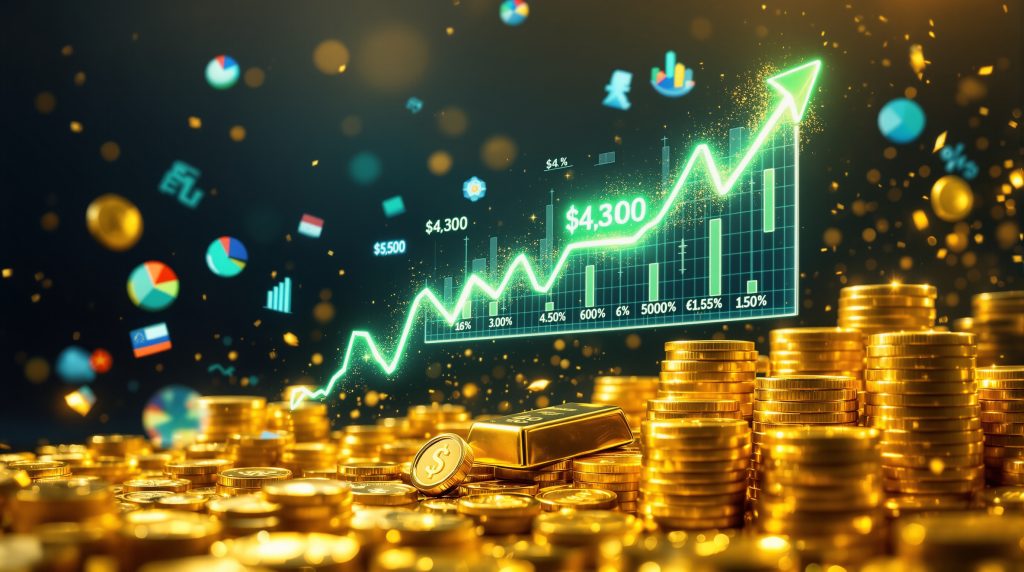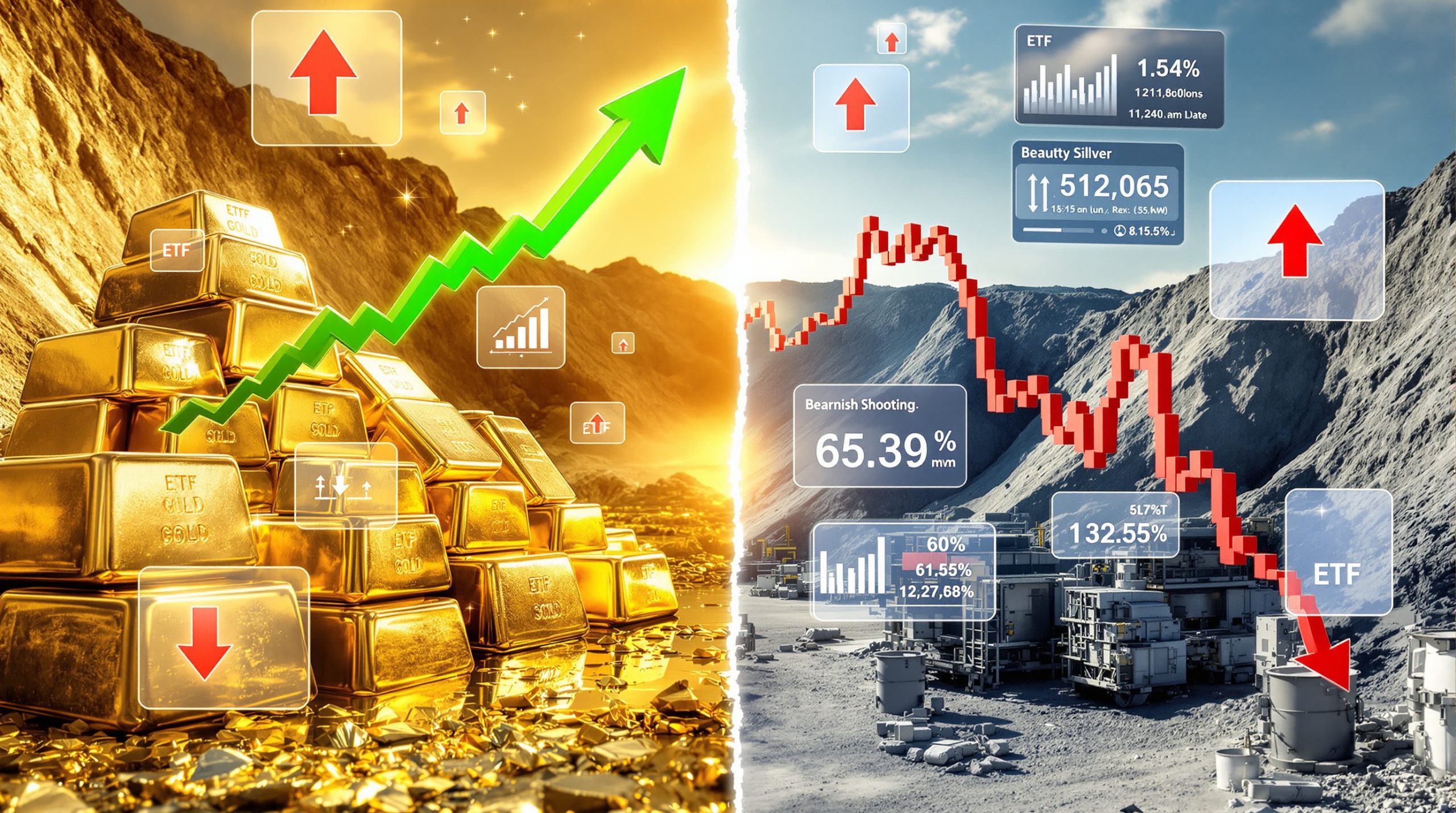Understanding Gold's Historic Rally: Key Market Dynamics
Gold's unprecedented surge beyond the $4,300 threshold represents a convergence of multiple economic pressures that have fundamentally altered precious metals markets. This historic milestone, where gold climbs above 4300 amid tariff turmoil, reflects deep-seated concerns about global economic stability, monetary policy shifts, and geopolitical tensions that continue to reshape investment landscapes worldwide.
The precious metal achieved its first-ever close above $4,200 per ounce during the week of October 17, 2025, despite experiencing a sharp Friday reversal that saw prices decline more than 2% intraday. This volatile trading pattern demonstrates the intense pressure building throughout the week before releasing in what market observers characterised as a mostly orderly fashion.
Key Price Drivers Analysis:
| Factor | Impact Level | Duration | Market Response |
|---|---|---|---|
| Trade War Escalation | High | Ongoing | +15-20% premium |
| Central Bank Policy Shifts | Medium-High | 6-12 months | Dollar weakness |
| Government Shutdowns | Medium | 3+ weeks | Data uncertainty |
| Geopolitical Tensions | High | Persistent | Safe-haven demand |
The trading dynamics reveal a systematic buildup of economic anxiety throughout the trading week, with Friday's $100+ single-session decline providing temporary relief without fundamentally altering the underlying bullish trajectory. Even after shedding significant value in one session, gold remained positioned to post another consecutive weekly gain of approximately 5% from Monday's opening levels.
How Do Trade Tensions Fuel Gold's Ascent?
International trade friction has emerged as the primary catalyst driving gold's meteoric rise above the $4,300 level. The reimposition of aggressive tariff policies creates a cascade of economic uncertainties that traditionally benefit precious metals as portfolio hedges against currency instability and inflation pressures.
The market's reaction to the announcement of 100% tariffs on several categories of Chinese goods demonstrates the immediate impact trade policy has on precious metals valuations. This policy announcement, which occurred during the week leading up to October 17, 2025, represented what analysts characterised as the re-acceleration of trade tensions between the globe's two largest economies.
Trade War Impact Mechanisms:
- Currency volatility from retaliatory measures weakens dollar stability across international markets
- Inflation expectations rise as import costs increase across multiple economic sectors
- Supply chain disruptions create broad economic uncertainty requiring safe-haven asset allocation
- Market sentiment shifts from risk-on to risk-off positioning among institutional investors
The subsequent rollback of these tariffs, with policymakers calling them "unsustainable," provided only temporary relief to markets. Economic experts suggest that the U.S. Dollar Index weakened significantly throughout the week, breaking below the critical 98.5 level before recovering during Friday's broader reversal.
However, the characterisation of tariff relief as temporary suggests market participants remain sceptical about lasting trade resolution. The rapid policy reversal within a single week demonstrates the volatile nature of trade relationships and their profound impact on precious metals markets.
What Role Does Monetary Policy Play in Gold's Performance?
Central bank positioning has become increasingly accommodative as economic headwinds intensify, fundamentally altering the investment calculus for non-yielding assets like gold. Federal Reserve expectations for rate cuts have shifted dramatically from previous timelines, creating sustained upward pressure on precious metals valuations.
Furthermore, our gold price forecast indicates that market concerns centre on the Federal Reserve's approach to interest rate policy throughout 2025. The central bank's reluctance to lower rates until September has created what analysts describe as overstress within the U.S. economy, leaving it vulnerable to potentially damaging recessionary pressures.
Monetary Policy Transmission Effects:
- Lower real yields reduce opportunity costs of holding precious metals relative to interest-bearing alternatives
- Dollar depreciation makes gold more attractive to international buyers and investors
- Liquidity expansion drives institutional allocation toward alternative assets beyond traditional securities
- Inflation hedging becomes more critical as monetary accommodation increases across global economies
Market Insight: Rate cut expectations have shifted from September 2025 to potentially earlier timeframes, with a growing consensus expecting another 0.25% reduction at the next Federal Open Market Committee meeting.
The evolution in monetary policy expectations reflects broader economic concerns about the sustainability of current interest rate levels. This shift has contributed significantly to gold's ability to maintain strength at historically elevated price levels, as investors position for a more accommodative monetary environment.
Why Are Government Shutdowns Amplifying Market Uncertainty?
Extended government shutdowns create information vacuums that markets particularly dislike, forcing investors to rely on incomplete economic data when making critical allocation decisions. The ongoing shutdown, lasting nearly three weeks as of October 17, 2025, with no apparent resolution in sight, has significantly contributed to the current situation where gold climbs above 4300 amid tariff turmoil.
The absence of critical economic data releases prevents accurate assessment of underlying economic conditions. Key indicators such as the September Consumer Price Index report have been indefinitely delayed, creating additional uncertainty about inflationary pressures and their potential impact on Federal Reserve policy decisions.
Shutdown-Related Market Distortions:
- Data delays prevent accurate economic assessment by investors and policymakers alike
- Policy uncertainty increases as legislative processes stall without clear resolution timelines
- Confidence erosion affects both consumer sentiment and business investment decisions
- Risk premium expansion grows as uncertainty duration extends beyond typical shutdown periods
The three-week shutdown period has coincided with gold's strongest performance, suggesting markets view political dysfunction as a persistent rather than temporary risk factor. This governmental paralysis compounds existing economic concerns about trade policy and monetary accommodation.
Critical Observation: The obfuscation created by lack of major macroeconomic data reporting on U.S. economic health forces market participants to operate with incomplete information, naturally favouring safe-haven asset allocation.
How Do Institutional Flows Support Higher Gold Prices?
Professional money management has increasingly embraced gold as both tactical and strategic portfolio allocation, providing sustained demand that supports higher price levels. The institutional approach to precious metals has evolved significantly, moving beyond simple diversification toward active risk management strategies.
Additionally, exchange-traded fund flows and central bank purchases provide foundational demand that underpins gold's historic price levels. This institutional participation creates a floor of consistent buying interest that helps stabilise markets during periods of intense volatility.
Institutional Demand Patterns:
| Institution Type | Allocation Strategy | Price Impact | Sustainability |
|---|---|---|---|
| Central Banks | Strategic reserves | Foundation support | Long-term |
| Pension Funds | Inflation hedging | Steady accumulation | Multi-year |
| Hedge Funds | Tactical positioning | Volatility amplification | Variable |
| ETF Investors | Accessibility plays | Retail participation | Market-dependent |
The Friday session's $100+ sell-off provided evidence of institutional profit-taking when policy uncertainties showed temporary resolution. This pattern suggests sophisticated money managers remain actively engaged in gold markets, ready to capitalise on both upward momentum and tactical selling opportunities.
Professional investors have demonstrated increasing sophistication in their approach to precious metals allocation, utilising gold as inflation hedge not merely as portfolio insurance but as an active component of risk-adjusted return strategies.
What Technical Factors Drive Intraday Volatility?
Gold's journey above $4,300 followed by sharp reversals illustrates the technical dynamics that characterise momentum-driven markets. Understanding these patterns helps explain both the rally's intensity and subsequent corrections that create trading opportunities for active participants.
The week's trading pattern demonstrated systematic pressure accumulation throughout Monday through Thursday sessions, with Friday's reversal representing controlled liquidation rather than panic selling. This orderly release of built-up pressure suggests market structure remains intact despite extreme price levels.
Technical Analysis Framework:
- Momentum indicators show extreme overbought conditions requiring periodic consolidation phases
- Volume patterns suggest institutional rather than retail-driven price movements during key sessions
- Support levels establish around previous resistance zones near the $4,200 threshold
- Volatility expansion creates both significant opportunity and elevated risk for active trading strategies
The 2% intraday decline on Friday demonstrates the velocity with which precious metals can move when technical conditions align with fundamental catalysts. This price action reinforces the importance of risk management at historically elevated valuation levels.
Market microstructure analysis reveals that gold's recent performance follows classical momentum patterns, with sustained directional moves interrupted by sharp corrections that test investor conviction and market liquidity.
How Does Global Economic Uncertainty Translate to Gold Demand?
Economic uncertainty manifests across multiple dimensions, from international trade relationships to domestic policy effectiveness. Reports from major financial outlets indicate that gold's traditional role as a store of value becomes more pronounced when conventional economic relationships break down and traditional asset correlations fail to provide adequate diversification.
The convergence of trade tensions, governmental dysfunction, and monetary policy concerns creates what analysts describe as an "imbalance of risk-on versus risk-off inputs" that naturally favours precious metals allocation. This multi-factor uncertainty environment supports sustained gold demand at elevated price levels.
Uncertainty Transmission Channels:
- Market correlation breakdown reduces diversification benefits of traditional asset classes during stress periods
- Currency instability drives international demand for politically neutral stores of value
- Credit risk elevation increases preference for counterparty-free assets without default risk
- Wealth preservation becomes priority over yield generation when economic visibility deteriorates
The persistence of multiple economic concerns suggests that narratives troubling to investors and money managers will remain prominent considerations for extended periods. This sustained uncertainty environment naturally supports continued gold strength despite short-term volatility.
Strategic Perspective: When more economic factors deteriorate than improve within a given timeframe, precious metals typically benefit from the resulting flight-to-quality investment flows.
What Are the Risks of Extreme Gold Valuations?
While gold's rally reflects legitimate economic concerns, extreme valuations carry inherent risks that investors must carefully consider. Understanding these limitations helps maintain realistic expectations about future performance and appropriate position sizing strategies.
Historic price levels introduce new dynamics that may not have been present during previous precious metals cycles. The velocity of recent gains suggests increased volatility will characterise future price movements regardless of overall direction, particularly in situations where gold climbs above 4300 amid tariff turmoil.
Valuation Risk Factors:
Storage and Insurance Costs: Physical gold ownership involves ongoing expenses that reduce net returns, becoming particularly significant at elevated price levels where absolute costs increase proportionally.
Opportunity Cost Considerations: Non-yielding assets become less attractive when alternative investments offer meaningful income streams, especially if interest rate expectations shift toward higher levels.
Liquidity Constraints: Extreme prices can reduce market depth and trading volume, making large institutional transactions more difficult to execute efficiently without market impact.
Correction Vulnerability: Momentum-driven rallies often experience sharp reversals when underlying fundamental conditions change rapidly, as demonstrated by Friday's trading action.
The $100+ single-session decline illustrates how quickly extreme valuations can correct when policy uncertainties show even temporary resolution. This price sensitivity to news flow increases as gold reaches historically elevated levels.
How Should Investors Position for Continued Volatility?
Gold's historic performance requires sophisticated approaches to portfolio integration that account for both opportunity and risk factors. Rather than binary exposure decisions, successful strategies often involve graduated positioning that can adapt to rapidly changing market conditions.
The extreme price levels and associated volatility suggest that traditional buy-and-hold approaches may be less suitable than more dynamic allocation strategies that can adjust to changing fundamental conditions. Our market surge insights provide valuable guidance for navigating these challenging conditions.
Strategic Positioning Considerations:
- Allocation sizing should reflect both opportunity potential and individual volatility tolerance levels
- Entry timing benefits from dollar-cost averaging approaches rather than concentrated lump-sum investment
- Exit planning requires predetermined criteria rather than emotional decision-making during volatile periods
- Correlation monitoring helps maintain desired portfolio risk characteristics as market relationships evolve
The difficulty in mapping potential pivot points for the following week, given continued governmental shutdown and delayed economic data, suggests investors should prepare for continued uncertainty and associated volatility.
Professional risk management becomes increasingly important at extreme valuation levels, where both upside potential and downside risk are amplified compared to more typical market environments.
What Does Gold's Rally Signal About Future Economic Conditions?
Gold's performance above $4,300 serves as a comprehensive barometer for broader economic health and stability. The sustained demand at these historic levels suggests markets expect continued challenges rather than temporary disruptions to economic normalcy.
In addition, the precious metal's ability to maintain strength despite sharp intraday corrections indicates underlying structural support from fundamental economic concerns. Our all-time high analysis shows that gold's role has evolved beyond traditional portfolio diversification toward primary hedging against systemic uncertainty.
Forward-Looking Indicators:
- Policy effectiveness concerns drive sustained safe-haven demand as traditional tools appear less reliable
- International cooperation breakdown requires hedging mechanisms against trade and diplomatic instability
- Monetary system stability questions support alternative store-of-value assets beyond fiat currencies
- Wealth inequality considerations increase precious metals appeal among diverse investor demographics
The convergence of trade tensions, monetary accommodation, and political uncertainty has created conditions where traditional safe-haven assets command unprecedented premiums. This environment suggests fundamental shifts in how markets assess risk, value, and long-term stability.
The persistence of multiple economic concerns, with analysts noting that "more things have stayed bad this week than have gotten better," indicates that gold's elevated pricing may reflect new baseline conditions rather than temporary market displacement.
Market Psychology and Investment Implications
The psychological aspects of gold's climb above $4,300 reveal important insights about investor behaviour during periods of extreme uncertainty. Market participants appear increasingly willing to pay substantial premiums for perceived safety and stability when traditional economic relationships become unreliable.
The systematic pressure buildup throughout trading weeks, followed by sharp but orderly corrections, suggests that professional investors are actively managing risk while maintaining strategic precious metals exposure. This behaviour indicates sophisticated understanding of gold's role in modern portfolio construction.
Behavioural Finance Considerations:
- Anchoring effects may influence future price expectations as $4,300+ levels become normalised
- Herding behaviour can amplify both upward momentum and correction magnitude
- Loss aversion may increase demand for portfolio insurance at any price level
- Recency bias might cause overweighting of recent extreme events in future planning
The ability of gold to recover quickly from sharp declines suggests strong underlying conviction among holders, even at historically elevated price levels. This conviction likely stems from the multiple, persistent nature of current economic uncertainties.
Furthermore, those seeking investment amid uncertainty must consider how extreme market conditions alter traditional risk-return calculations and require more nuanced approaches to precious metals allocation.
Conclusion: Navigating Gold's New Price Reality
Gold's historic climb above $4,300 represents far more than a numerical achievement—it reflects fundamental shifts in how markets assess risk, value, and long-term economic stability. The convergence of trade tensions, monetary accommodation, and political uncertainty has created conditions where traditional safe-haven assets command unprecedented premiums.
The week's trading pattern, characterised by sustained pressure accumulation followed by sharp but orderly correction, demonstrates the complex dynamics governing precious metals at extreme valuation levels. Despite Friday's $100+ decline, gold maintained its position for another consecutive weekly gain, illustrating the underlying strength of fundamental demand drivers.
Investors must balance gold's proven hedging capabilities against the inherent risks of extreme valuations and associated volatility. The velocity of recent price movements suggests that traditional investment approaches may require modification to account for the new reality of precious metals markets operating at historic levels.
The key to navigating this environment lies in understanding that gold's role has evolved from simple portfolio diversifier to primary hedge against systemic uncertainty. This evolution requires sophisticated approaches that can adapt to rapidly changing conditions whilst maintaining focus on long-term wealth preservation objectives.
The persistence of multiple economic concerns, from governmental dysfunction to trade instability and monetary policy uncertainty, suggests that the conditions supporting gold's historic performance may prove more durable than temporary market disruptions. The circumstances where gold climbs above 4300 amid tariff turmoil demonstrate how multiple risk factors can converge to create sustained precious metals strength.
Successful navigation of this environment will require both tactical flexibility and strategic patience as market participants adjust to the new reality of precious metals operating at previously unimaginable price levels.
Disclaimer: This analysis is for educational purposes only and should not be considered personalised investment advice. Precious metals investments carry significant risks, including price volatility and the potential for substantial losses. Past performance does not guarantee future results. Consult with qualified financial professionals before making investment decisions.
Are You Positioned to Capitalise on Tomorrow's Major Discovery?
Discovery Alert's proprietary Discovery IQ model delivers instant notifications on significant ASX mineral discoveries, transforming complex geological announcements into actionable trading opportunities before the broader market reacts. Just as gold's unprecedented rally above $4,300 demonstrates how rapidly precious metals markets can move, historic mineral discoveries have generated exceptional returns for investors who positioned themselves ahead of major announcements.




